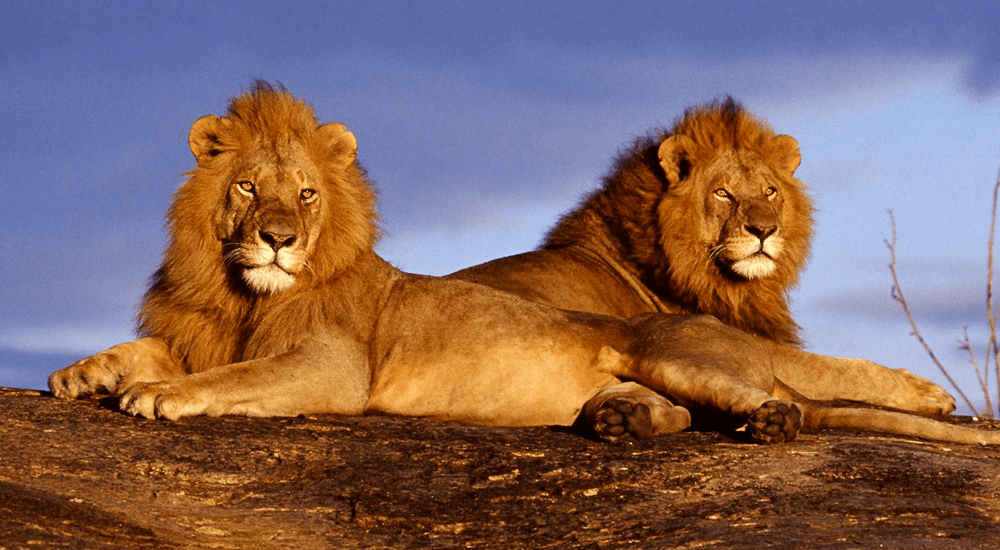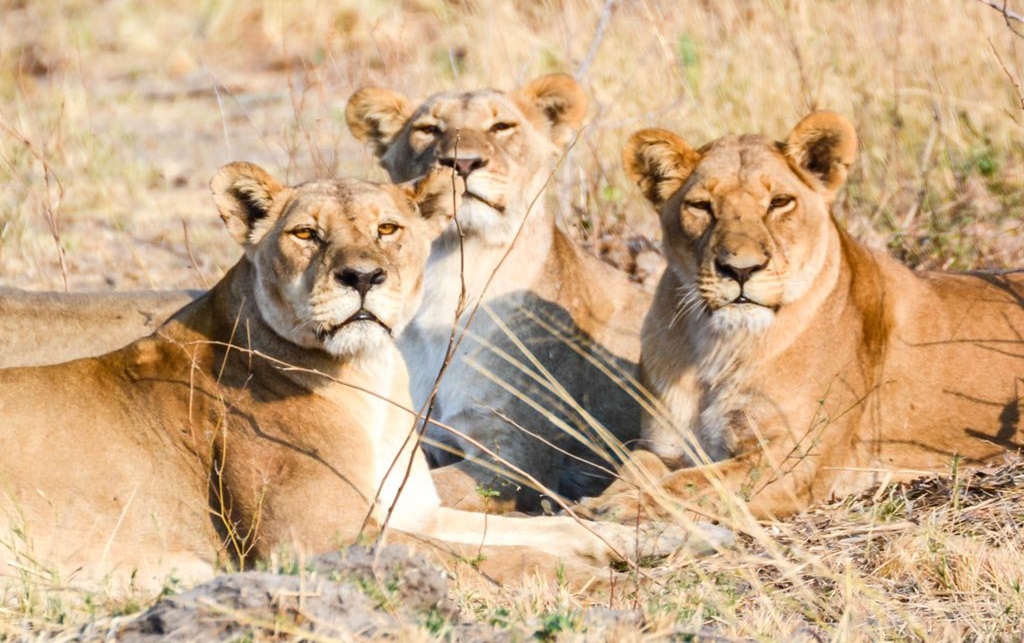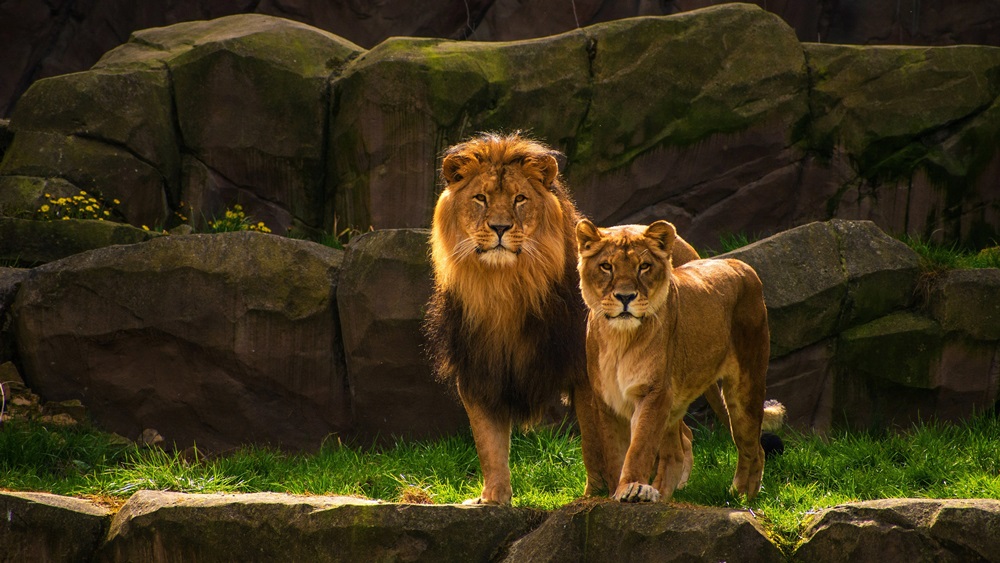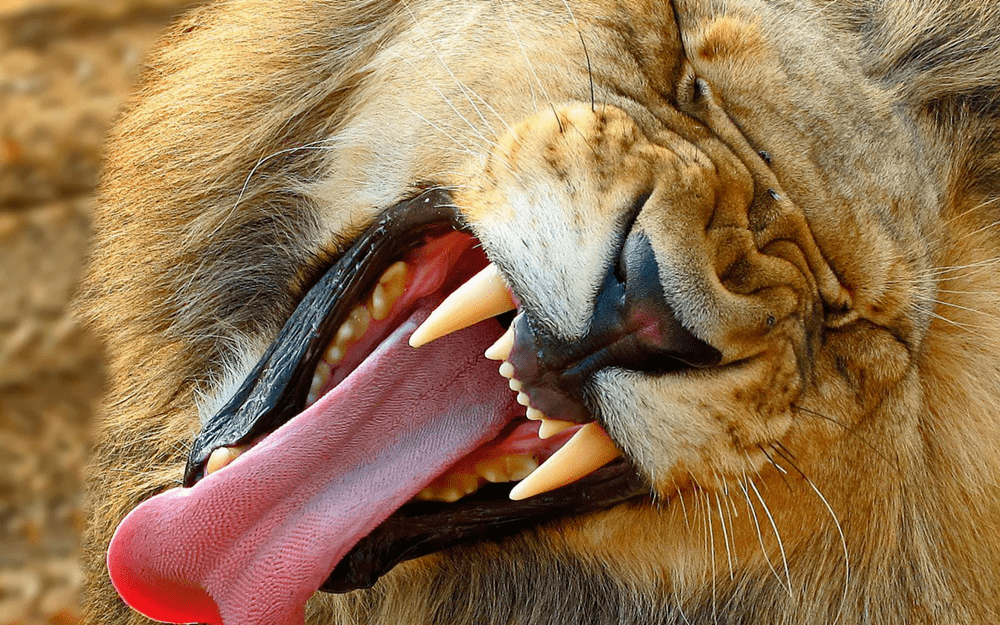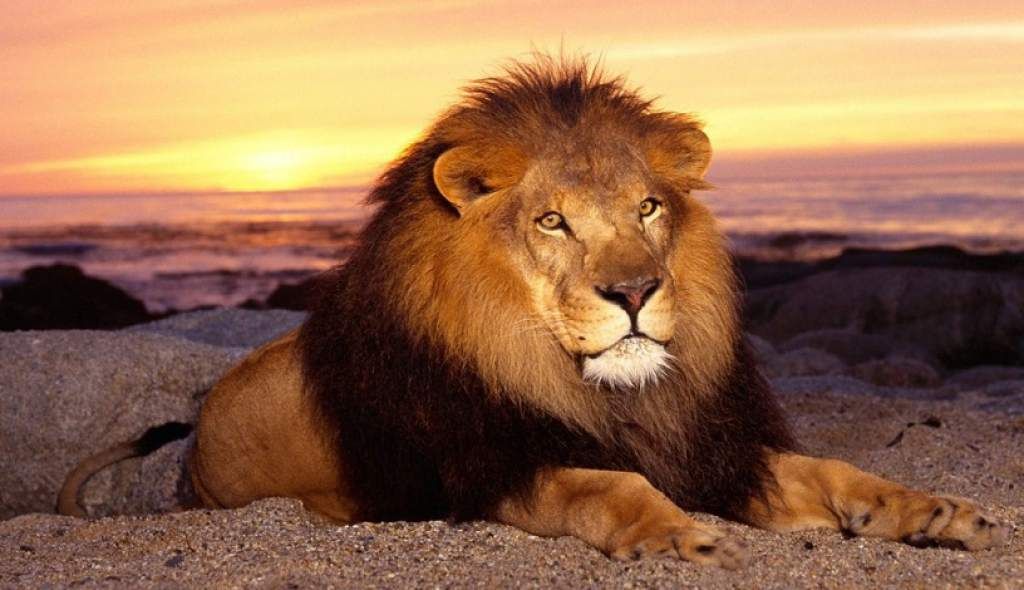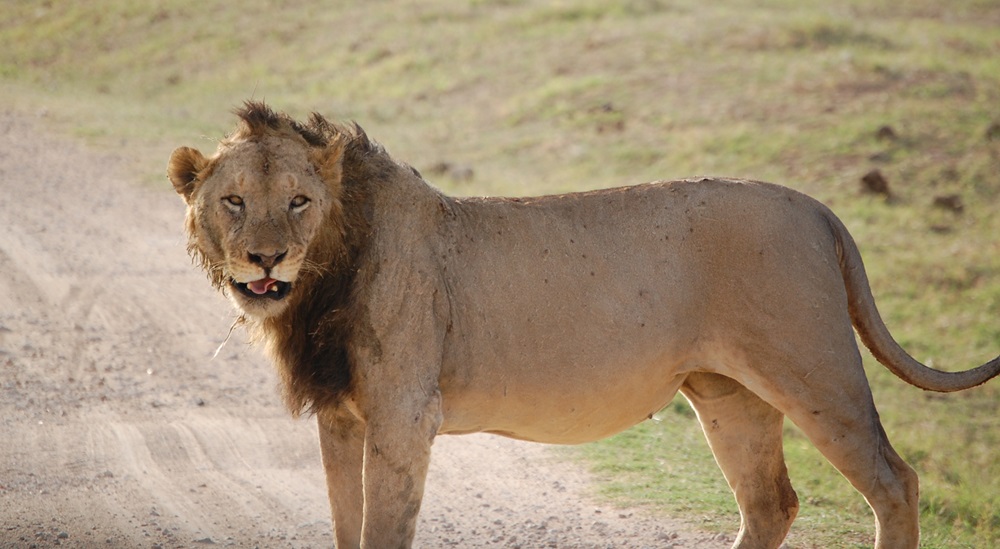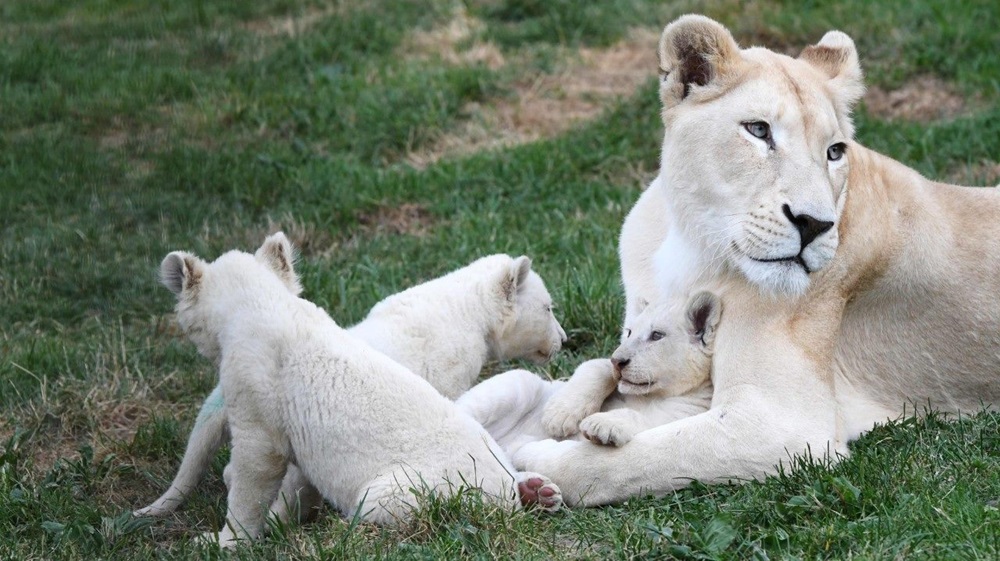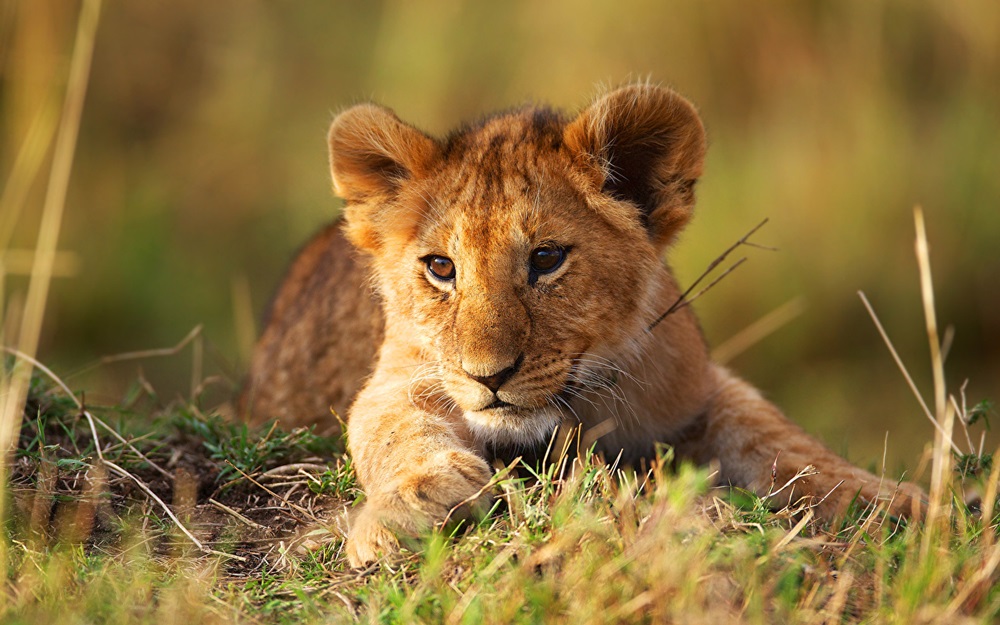The leones, also known as the kings of the jungle, are the second largest feline in the world. Imposing and beautiful, these animals are one of the best known felids in the world, it is said that in the past, there were so many lions that apart from humans, it was the largest population on the planet.
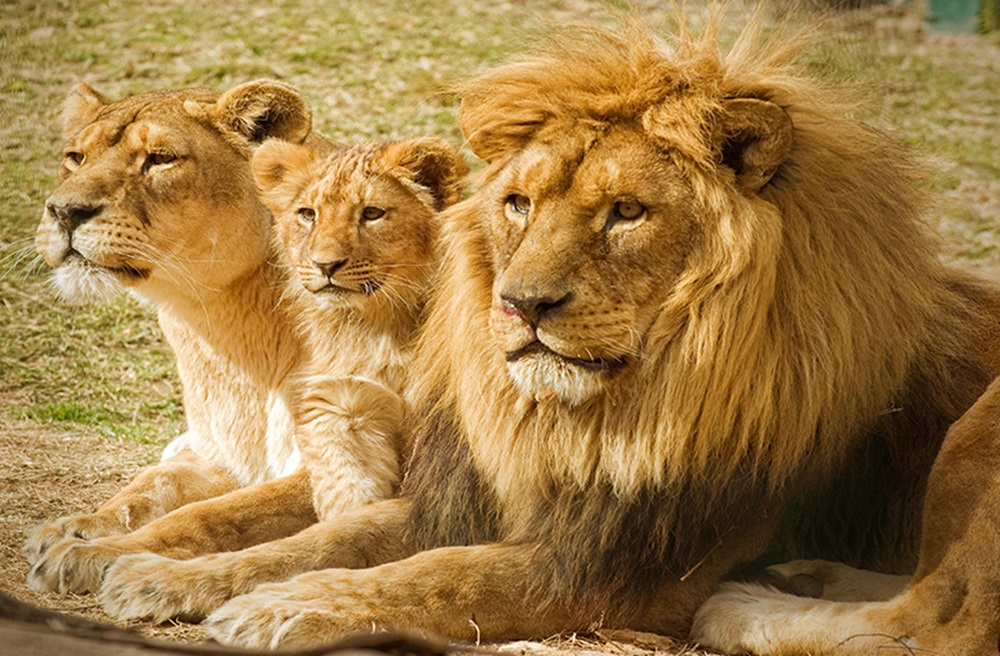
Let's learn about lions
The scientific name of the animal lion is "panthera leo", these are animals that feed on other living beings, so they fall within the group of Carnivorous animals. Usually, male lions are much larger than females when they reach adulthood, they can weigh approximately 250 kilos, which is why it is considered the second largest feline, knowing that the first, by obvious reasons, it Tiger.
We can find these imposing animals within the African and Asian continent, although sadly, in India, the lions are in critical danger, because their population has been reduced so much that it will not be long until they become extinct in that place if not Extreme protection and conservation measures are taken for the species.
In ancient times, approximately 10.000 years ago, lions were the second largest mammalian species on Earth. The one who occupied the first position was, of course, the human being. The population of these cats was so extensive that they could be seen on all the continents of the world, although their largest population was always found in Africa. However, thanks to the dark hand of man, this has completely changed, now, unlike before, very few lions are still in the wild.
the life of lions cubs is not easy, so very few survive and become adult lions. In general, these animals can live for approximately 14 years, as long as they are in protected places, otherwise they would live much less because of poaching. Currently, there are national parks that fulfill the function of giving animals in the wild the best possible life.
The lions that are within these protected territories can live a long time, because their habitat is much more complete, they have constant food, water and above all, they are protected from the evil of man. However, those lions that live in precarious areas of necessary elements, for the most part, do not live more than 8 years, since their life situation is much more complex, in general, they have strong dry seasons where not only water is scarce, but also food and quality of life.
However, there are clear records showing that there were some lionesses who managed to live around 19 or 20 years even though they were living in their natural state, which is why it is believed that females have much more capacity to live for longer. time, because they are the ones that generally provide food and should not fight with the male lions to protect territory or the pride, although, if necessary, they will do so with the same integrity as the males.
It should be noted that those lions that are in captivity and have adequate care, most of them live more than 20 years of age.
Although lions have the ability to live in forests or jungles where vegetation is abundant, they prefer to live in slightly more open areas such as savannahs. However, these animals can easily adapt to different environments, even those that do not have trees to give them shade, such as deserts.
Unlike most felines, these Wild animals They are not solitary animals, on the contrary, they prefer to live in large groups called "herds". In general, these herds are quite numerous, females predominate in terms of quantity, all of them sharing blood ties.
Within a pride, males are rare, in some groups, there may be only one lion, although in others there may be more. However, the only way that there can be several males in the same pack is that they are brothers and, in general, belong to the same litter or are very close.
In these families of lions, the females are in charge of hunting, in most cases, they all hunt in groups, leaving the youngest and most inexperienced ones to take care of the young. Something that changes when necessary, because everyone would participate there, even, in some cases, the males enter the game and help their females to obtain the prize.
In general, lions are strong predators, they are important for the balance of the animal kingdom, although they, if they see the need to do so, go from being predators to scavengers, especially those that live in habitats where food can occasionally be limited. As a general rule, lions do not see humans as possible prey, however, there are some specimens that, for one reason or another, begin to have humans among their main prey. Although this is not very common to happen.
Currently, the lion is a very vulnerable species and close to being in a state of alarm, since in Africa, its largest habitat, there has been a considerable loss of the species. Recovering the species will not be an easy task, it is not even known if it can be achieved.
Within Africa, most of these animals live within Nature Reserves or National Parks dedicated to the conservation of species, so they are not fit to live in a 100% natural way. If they do, they could be in danger and even the species would end up almost immediately extinct.
To this day, it is not known exactly, the true or main reason why the species of lions has been declining so quickly and steadily, however, what we are all clear about is that much of the It is the fault of the human being, since it has been the man who has destroyed a large part of the habitat of these felines and in addition to that, and the most serious thing, is that it is the human who hunts these beautiful and important animals.
Many of these Animals of africa They have been in captivity since Ancient Rome, where these animals had to fight gladiators for their lives. From those times onwards, this species has always been much sought after by those zoos and circuses who loved to brag about having these felines under their domain. However, at present, the zoos that keep this species in captivity are collaborating with the conservation of the species, as they do everything possible so that more offspring are born, which are protected.
In addition to that, today, there are many countries that have joined the ban on keeping animals in circuses, since most of them are mistreated animals that live their entire lives inside small cages that are not suitable for them, In addition to that, the quality of life is not what they deserve.
Characteristics of lions
Lions are strong, large and powerful mammals, they have extremely strong legs that can easily knock down an adult human being, their jaws are powerful, as it is made up of large canines that can measure up to 8 centimeters long. All these characteristics are what make the lion one of the strongest predators on the planet.
These animals have a variability of colors that can range from grayish beige to a darker color that can be golden brown, reddish brown or even a slightly darker ocher tone. This in the upper part of its body, because in the lower part, chest, belly and back of the legs, they are usually a much lighter tone, often becoming almost white. On the other hand, the lion's tail has a small bush of black hairs at its tip and which can vary and be a dark brown, almost reaching black.
Lion cubs, in their earliest ages, have spotted patterns on their fur that help them camouflage themselves in their environment, since they are mostly hidden within areas with vegetation and shade. These spots lighten until they disappear as the cub grows, however, some lionesses keep these spots on their chest or belly, although in very light shades.
In the animal kingdom, lions are the only felines that show a great and evident difference between males and females, since they have obvious characteristics that differentiate them from each other. In the case of females, they lack the mane that males do have, since it would not be useful during hunting hours, since it would not allow them to camouflage themselves as they do when they stalk their prey.
The mane of lions varies both in abundance and color, as it can range from yellow or blonde to black. The males that have clear manes, with the passage of time tend to change and darken a little. Size is usually another quite noticeable factor, since the female is much smaller than the male.
lions size
In general, male lions tend to weigh between 150 and 250 kilograms, while females weigh between 120 and 180 kilograms, although, in Kenya, a male specimen was found that had died and he himself weighed 272 kilos. However, statistically, the average weight of males tends to be 180 kilos and that of females 125 kilos.
The weight and size of the lions will vary depending on the habitat in which they live, since some African lions that live in the eastern part of the country are a little smaller than those that live in other areas of Africa. Hence, the variability in the weight and size records of these felines.
The size of the head and body of lions is usually between 170 and 250 centimeters, while that of females is 140 or 175 centimeters. The same happens with the tail and the height of the shoulders of these animals, the length in males is greater than that of females. Until now, the largest male in length recorded was one that was found dead thanks to a gunshot. The heaviest, was one that used to hunt humans to eat which was hunted and weighed 313 kilograms.
Lions in captivity are usually larger and heavier than lions in the wild. Until now, the heaviest captive lion in the world was one that lived in a zoo belonging to a city in England, it had the name "Simba" because it paid homage to the famous Disney lion, this specimen weighed 375 kilos.
teeth and tongue
When we talk about the teeth of lions, we can say that it is very complete and dangerous, since it is made up of 4 pointed canines that can measure up to 8 centimeters, they are semi-curved for better penetration. Their molars and premolars are also sharp, ideal for being able to tear pieces of meat from their prey and thus be able to ingest them.
As for the tongue of these powerful mammals, like that of the rest of the felines, it is composed of a large number of filiform lingual papillae, which is very useful when the animal needs to take off the meat from the bone of its prey. In this way, the lions are able to eat everything without leaving anything for the scavengers.
Due to the size and dexterity of lions with their tongues, they can use it to groom themselves, although many do not know it, lions are able to use their tongue as a kind of comb that helps them remove the ticks from your body. In the case of females, they take on the task of grooming their puppies, in this way, they clean their fur and rid them of possible ticks that have adhered to their bodies.
Unlike dogs, felines do not need to place their tongues in a spoon position to drink water, when they introduce their tongues into the water, drops of the liquid remain impregnated in the filiform papillae, in this way, they enter into the mouth allowing the feline to drink the water accumulated from the various drops.
lions paws
The legs of the lions have a similar shape to that of other existing felines, however we must take into account their size. An adult male's leg can be as large as, and in some cases even larger than, an adult male's face. They are equipped with large and sharp retractable claws that could easily tear their prey apart with a single claw.
Mane of the lion
The mane of male lions is undoubtedly the most striking and well-known characteristic of these animals, they are the only felines that have one. While the mane is larger, the larger it makes the lion appear, so its main use is to make the feline appear to be much larger and more intimidating than it already is, especially in front of other males of its species or hyenas stained. The latter being the species that is on a par with lions when it comes to competition for food.
The abundance, color, scarcity and even the lack that a lion may have of its mane, will always be due to genetics, hormones, age and the conditions in which the animal is found and lives. Well, the mane of a healthy adult male who lives in a habitat where food and water are not scarce will not be the same as that of a malnourished or sick adult male who in the worst times of the year will feed on the little carrion he can find. It is believed that if the male has an abundant and dark mane, we are looking at a healthy specimen.
Previously, people thought that the male lion that had a much more abundant and thick mane was at an advantage over his opponent of the same species and gender, since it was assumed that it protected him from the bites and claws of his fighting partner. . However, it has been confirmed that this does not intervene at all, since lions with less mane have been seen easily beating another male even when he had a much more abundant mane.
In addition to this, there are other felines in the world that must also fight for their food, territory or for the right to mate, however, they completely lack mane, so the advantage of the winner lies solely in strength. , vitality and agility that each of the felines have, regardless of their species.
Some scientists took the task of observing the lions that are found within the territory of the Serengeti National Park in Tanzania, with the firm intention of being able to understand what was the use of the lion's mane in addition to making it seem more intimidating than it would be. itself, it already was. After a time of observation, they noticed that those males with abundant, long and dark manes were more likely to mate than those with lighter and sparser manes.
Therefore, it is assumed that lionesses prefer males that have a much more striking and darker mane, this is because it is a clear representation of good genes and that the animal is in a healthy state. optimum. According to studies, dark-maned lion cubs were more likely to survive their first 5 years of life than light-maned ones. However, the disadvantage of having a black mane or reaching that tone, is that it makes the animal have a higher body temperature.
Currently there are records of maneless lions, some specimens have been observed in Senegal and Kenya, in addition to the lack of abundance of it in those white lions found in Timbavati. Something that we must be clear about is that lions that are castrated will have sparse manes, due to the lack of production of testosterone and other sexual hormones.
We must also highlight the fact that herds have been known to share the same blood, that is, that the males mate with their neighbors, where the male offspring lack a mane when they grow up. It has been proven that these males without mane or with scarce mane tend to have fertility problems, since their hormones are scarce or deficient, which is why, in general, females decide not to mate with them since their puppies they will not be strong and will have less chance of survival.
Lionesses have a kind of collar around their jaws that some people tend to confuse with a mane. These collars are not very noticeable, it can only be seen when the female is in some positions. In some works and drawings from ancient times, you can see these necklaces, which many confuse with a mane, however they are very different.
These necklaces only appear in the jaw area of the female, the hair strands are much shorter and do not grow between the ears. On the other hand, the mane is much longer, abundant and in the most extreme cases, it can even cover the male's ears in a certain way, only leaving the ear canal exposed.
There are paintings of the now extinct cave lions of Europe where all the specimens are shown devoid of mane, they want to make us understand that in those times, the male did not have one. However, in the works, they are seen to be hunting, so it is believed that they are female specimens and not males. Studies say that lions have not changed their hunting strategy for thousands of years, so with more reason, it is believed that in the paintings, females are reflected hunting and not male lions.
white lions
Some scientists believe that the gene that makes a lion white has been in the genes of the species forever, however, as it is a recessive gene, that is, weak, it is not very common to occur. The first white lion was registered in 1970, however, we must understand what, it was from that time, where scientists managed to get closer to the species to study it.
It is generally known that white lions living in the wild do not usually live very long. This is because the color of their fur is very striking and does not allow them to camouflage themselves as a common lion would, so eating and even protecting themselves is an extremely complex task for these striking specimens.
reproduction of the lions
By the time lionesses reach four years of age, most of them have already reproduced at least once. The males do not have a heat season unlike the females, they can reproduce at any time of the year as long as they are near a female in heat. Females, on the other hand, can enter the reproductive state several times during the year.
The penis of the lions, as well as that of all cats, have a kind of inverse barbs that, when they are removed, scratch the inner walls of the female's vagina, this action has the effect of making the female ovulate.
In general, females, if available, can mate with different males during their reproductive cycle. Lions in general can copulate around 160 times in 60 hours. Unlike other species, lions reproduce with incredible ease even in captivity.
Hatchlings
Usually, females gestate for almost four months, as they have a gestation cycle close to approximately 110 days. Each litter can have between 1 and 4 puppies. Usually, the females give birth in a burrow or in areas with abundant vegetation that is slightly isolated from their herd.
During this period of isolation, the mother will hunt alone without straying too far from where her cubs are. The young at birth are completely defenseless, because they, like other cats, are born blind and their eyes will not open until about 8 or 10 days after they were born. They are able to walk by the third week of life while they will crawl before then.
The most common is that the mother, along with her young, return to the herd when the cubs are about two months old, however, in some cases, when other females have had young at the same time, the females usually return a little before that time.
It is very natural that in the herds, the females synchronize their mating season in order to have offspring almost simultaneously, in this way, all of them will be able to help each other with the upbringing, care and feeding of the puppies, since the little ones usually suckle from any of the lactating females that are close to it.
When cases occur where a female gives birth to a cub out of season, it may be the case that it has much more difficulty feeding, since the older ones will be more dominant and stronger, causing the little one to be relegated. . If this happens, it is very likely that the calf will starve or begin to have nutrition problems.
The pups in general are vulnerable, as they are often easy prey for many predators and even for males that are not from the pack. The young are usually eaten by leopards, large snakes, eagles, jackals and even hyenas and buffaloes, the latter, although they do not eat them, they do kill them when they stampede, because their way of protecting themselves and trying to have fewer lions near their herd.
Despite beliefs, not only young males are expelled from the herd where they were born. With the females it can also happen, only this happens, especially within those very large herds, where the young females are forced to create a different herd, for this reason, they are expelled although in a much more subtle way than with the males.
feeding of the lions
As we already know, these animals are carnivorous, their prey usually weigh between 50 kilos and half a ton, however, they can even eat small prey such as rabbits, rodents or birds. In general, it is the females who do the hunting, working together and using various corralling tactics. The male does not participate often because his mane usually exposes him because it is so striking.
The diet of the lions is very varied, they can hunt zebras, impalas, wildebeest, buffalo, wild boar, gazelle, deer, everything will depend on the availability of food within their territory. There are documentations, where lionesses have been seen hunting or at least stalking, elephants and young giraffes, especially in times when food is scarce.
Anthropophagy
When we talk about anthropophagy, we refer to those lions that hunt and kill humans as if it were just another prey item in their diet, that is, they do it indiscriminately.
Usually this occurs in male specimens. Several specific cases have been known where this happens, especially in Africa. In all these cases, the lions in question were hunted, as they presented a high risk to the population. In some cases, the hunters have written books explaining this rare behavior of the lion and recounting everything that happened from the first victim to the death of the feline.
In most of the cases studied where the lion suffered from anthropophagy, the animal was not in good health, they had deformed or rotten teeth, they lacked mane, they were much larger than a regular specimen and much more aggressive, since their behavior was totally different from the usual behavior of the species.
If a lion is exposed to places where large numbers of humans have died and is able to feed on them, there is a risk that the animal will begin to exhibit a strong attraction to human flesh and blood.
Although this is not something that happens often, we must bear in mind that, at least in African territory, most of the poorest peoples are established within the territories of these felines, so they run much higher risk of being attacked by some of these animals, either because they are hungry, sick or injured, and their way of protecting themselves is by attacking anything they consider a threat.
